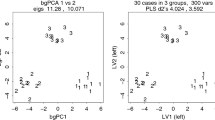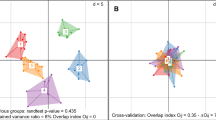Abstract
For the investigation of the relationships between two datasets where the individuals are divided into groups a simple procedure called multi-group pls regression is discussed. It is a straightforward extension of pls regression to take account of the group structure. It can also be seen as an extension of multi-group principal components analysis to the case of two blocks of data. The proposed method of analysis is illustrated on the basis of a real case study pertaining to the field of veterinary epidemiology.
Access this chapter
Tax calculation will be finalised at checkout
Purchases are for personal use only
Similar content being viewed by others
References
W. W. Chin, L. Barbara, and P. R. Newsted, “A partial least squares latent variable modeling approach for measuring interaction effects: Results from a monte carlo simulation study and voice mail emotion/adoption study,” Information Systems Research 14, pp. 189–217, 2003.
I. Dohoo, C. Ducrot, C. Fourichon, A. Donald, and D. Hurnik, “An overview of techniques for dealing with large numbers of independent variables in epidemiologic studies,” Prev. Vet. Med. 29, pp. 221–239, 1997.
I. Dohoo, W. Martin, and H. Stryhn, Veterinary Epidemiologic Research, Atlantic Veterinary College Inc., University of Prince Edward Island, 2010.
J. J. Hox, Multilevel Analysis: Techniques and Applications, Quantitative Methodology Series, p. 304, 2002.
B. Huitema, The Analysis of Covariance and Alternatives: Statistical Methods for Experiments, Quasi-Experiments, and Single-Case Studies, John Wiley & Sons, p. 688, 2011.
K. Jorgensen, V. Segtnan, K. Thyholt, and T. Næs, “A comparison of methods for analysing regression models with both spectral and designed variables,” J. Chemometr. 18, pp. 451–464, 2004.
G. Keppel, Design and analysis: A researcher’s handbook, 3rd edn., I. Englewood Cliffs: Prentice-Hall, 1991.
W. Krzanowski, “Principal component analysis in the presence of group structure,” J. Appl. Stat. 33, pp. 164–168, 1984.
C. Lupo, S. L. Bouquin, L. Balaine, V. Michel, J. Peraste, I. Petetin, P. Colin, C. Chauvin, “Feasibility of screening broiler chicken flocks for risk markers as an aid for meat inspection,” Epidemiology and Infection 137, pp. 1086–1098, 2009.
T. Næs, O. Tomica, B. H. Mevikb, and H. Martens, “Path modelling by sequential PLS regression,” J. Chemometr. 25, pp. 28–40, 2011.
M. Stone, “Cross-validatory choice and assessment of statistical predictions,” J. Roy. Statist. Soc. Ser. B 36, pp. 111–147, 1974.
Y. Takane, and H. Hwang, “Generalized constrained canonical correlation analysis,” Multivariate Behavioral Research 37, pp. 163–195, 2002.
Y. Takane, and S. Jung, “Generalized constrained redundancy analysis,” Behaviormetrika 33, pp. 179–192, 2006.
M. Tenenhaus, La régression PLS. Théorie et pratique, Paris: Technip. pp. 254, 1998.
M. Tenenhaus, E. Mauger, and C. Guinot, “Use of uls-sem and pls-sem to measure a group effect in a regression model relating two blocks of binary variables,” in Handbook on Partial Least Squares: Concepts, Methods and Applications, pp. 124–140, Springer, 2010.
J. A. Westerhuis, T. Kourti, and J. F. MacGregor, “Analysis of multiblock and hierarchical PCA and PLS model,” J. Chemometr. 12, pp. 301–321, 1998.
H. Wold, “Estimation of principal components and related models by iterative least squares. In P.R. Krishnaiaah (Ed.),” Multivariate Analysis, pp. 391–420, New York: Academic Press, 1966.
Author information
Authors and Affiliations
Corresponding author
Editor information
Editors and Affiliations
Rights and permissions
Copyright information
© 2013 Springer Science+Business Media New York
About this paper
Cite this paper
Eslami, A., Qannari, E.M., Kohler, A., Bougeard, S. (2013). Multi-group PLS Regression: Application to Epidemiology. In: Abdi, H., Chin, W., Esposito Vinzi, V., Russolillo, G., Trinchera, L. (eds) New Perspectives in Partial Least Squares and Related Methods. Springer Proceedings in Mathematics & Statistics, vol 56. Springer, New York, NY. https://doi.org/10.1007/978-1-4614-8283-3_17
Download citation
DOI: https://doi.org/10.1007/978-1-4614-8283-3_17
Published:
Publisher Name: Springer, New York, NY
Print ISBN: 978-1-4614-8282-6
Online ISBN: 978-1-4614-8283-3
eBook Packages: Mathematics and StatisticsMathematics and Statistics (R0)




